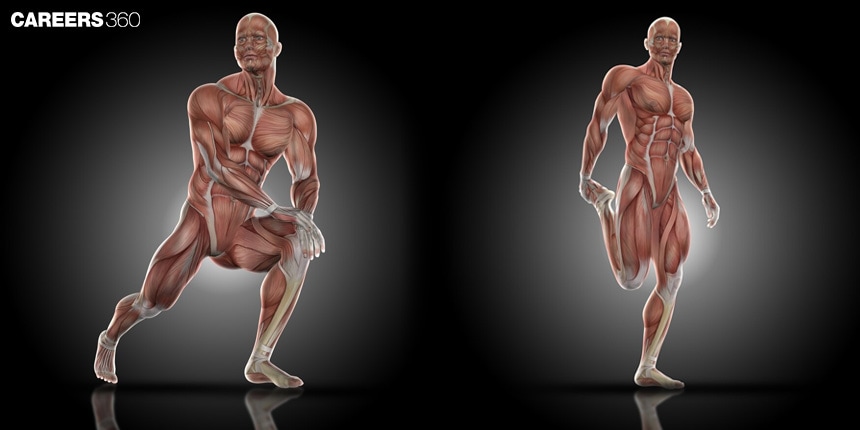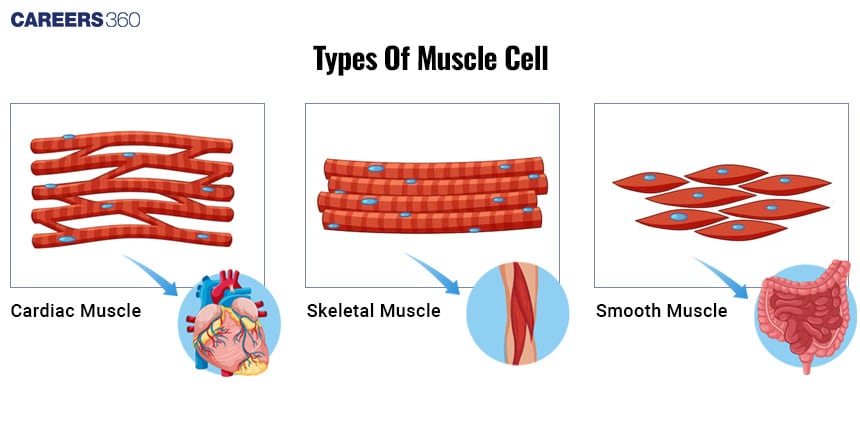Muscles: Types, Groups, Anatomy, Functions, Composition, Development
Muscles are specialized tissues responsible for movement and support in the human body. They work by contracting and relaxing, enabling various actions like walking, lifting, and even maintaining posture. In this article, muscles, types of muscles, muscle structure, muscle function, and common muscle disorders and diseases are discussed. Muscles are a topic of the chapter Locomotion And Movement in Biology.
NEET 2025: Mock Test Series | Syllabus | High Scoring Topics | PYQs
NEET Important PYQ's Subject wise: Physics | Chemistry | Biology
New: Meet Careers360 B.Tech/NEET Experts in your City | Book your Seat now
- What are Muscles?
- Types of Muscles
- Muscle Structure
- Muscle Function
- Common Muscle Disorders and Diseases

What are Muscles?
Muscles are specialised tissues in the human body whose major function is to move by their ability to contract. They are essential for a wide range of operations or activities that occur or take place within the body, such as maintaining posture, providing means and enabling locomotion, and assisting in critical functions like breathing and digestion. They contribute to overall health by way of supporting the skeletal system, protecting the internal organs, and offering help in metabolic processes.
Muscles take part in movement but play a crucial role in the overall health of the body. Regular muscle activity improves cardiovascular health, supports metabolic functions, and aids in maintaining a healthy weight. Other than daily movements, muscle strength is also vital for daily acts and the prevention of injuries of any type.
Types of Muscles
The types of muscles in the human body are broadly divided into three categories: skeletal, cardiac, and smooth muscles.
Skeletal Muscles
They are striated in appearance.
Multinucleated fibers
Voluntary control
Fixed to bones by tendons
Extensively in limbs and torso
Cause movement due to contraction and relaxation abilities
Examples: Biceps brachii (arm), Quadriceps femoris (thigh)
Cardiac Muscles
Striated with intercalated discs
One nucleus per cell
Involuntary
In the Walls of the heart (myocardium)
Pump blood throughout the body
Contraction occurs continually in a rhythmic manner.
Smooth Muscles
Not striated
One nucleus per cell
Autonomic nervous control
In the Walls of hollow organs (e.g., intestine, blood vessels)
Move substances along the body
Examples: Muscles in the digestive tract, blood vessel walls.

Also Read:
Muscle Structure
Muscle structure is complex, comprising different parts that interact to produce contraction and movement.
Muscle Fibers
Elongated, cylindrical cells
Several nuclei peripherally located
Sarcomere: The Functional Unit
Repeating units of myofibrils
Units responsible for muscle contraction
Myofibrils, Actin and Myosin Filaments
Myofibrils: Contractile threads within muscle fibers
Actin (thin) and myosin (thick) filaments: proteins involved in contraction.
Connective Tissue Components
Endomysium: surrounds individual muscle fibres
Perimysium: encases bundles of fibres (fascicles)
Epimysium: encloses the entire muscle
Tendons and their Role in Muscle Attachment:
Connect muscles to bones
Transmit force from muscle contraction to the skeleton.
Muscle Function
The mechanism of muscle function centres on the process of contraction and how muscles contract.
Sliding Filament Theory:
Actin and myosin filaments slide past each other
Shortens the sarcomere, producing contraction.
Role of ATP and Calcium Ions:
ATP provides energy for contraction
Calcium ions control the interaction of actin and myosin.
Neuromuscular Junction and Action Potential:
Synapse between a motor neuron and muscle fibre.
Action potential leads to muscle contraction.
Isotonic and Isometric Contractions:
Isotonic: length of the muscle changes (e.g. lifting a weight)
Isometric: muscle does not change in length (e.g. holding a position)
Concentric and Eccentric Contractions:
Concentric: Muscle shortens when contracting
Eccentric: Muscle lengthens when contracting
Common Muscle Disorders and Diseases
Several disorders and diseases can compromise muscle and thus function and quality of life.
Muscular Dystrophy
Duchenne muscular dystrophy: Progressive muscle weakness
Becker muscular dystrophy: Similar but milder
Genetic Basis and Treatment Options:
Genetic mutations that alter muscle proteins.
Treatment is symptomatic and aims to retard the progression.
Myasthenia Gravis
Muscle weakness, fatigue
Autoimmune disorder at the neuromuscular junction.
Treatment and Management:
Medications aimed at improving nerve-muscle communication.
Immunosuppressive therapies.
Muscle Cramps and Strains
It is caused by dehydration, overuse, and electrolyte imbalance.
This can be prevented by regular stretching and proper hydration.
Treatment and First Aid:
Rest, application of ice, compression, elevation (RICE)
Gentle stretch and rehydrate
Also Read:
| Ribs and Rib Cage | Vertebral Column |
| List of 206 Bones in Body | Pectoral Girdle |
| Axial Skeleton System | Appendicular Skeleton System |
Recommended Video on Muscles
Frequently Asked Questions (FAQs)
The three types of muscles are skeletal, cardiac and smooth muscles.
According to the sliding filament theory, actin and myosin filaments slide past each other to shorten the muscle.
Skeletal muscles are voluntary and striated. Cardiac muscles, on the other hand, are involuntary and striated but with intercalated discs. Smooth muscles are involuntary and non-striated.
Strengthening of muscles occurs with the inclusion of resistance training, enough quantities of protein, and regular physical activities.
Dehydration, according to some causes, muscle cramps; overuse equally causes it, and lastly, electrolyte imbalance. Prevent them by keeping hydrated, stretch your muscles often, and keep the electrolytes in balance.
Also Read
30 Nov'24 06:17 PM
28 Nov'24 05:27 PM
28 Nov'24 04:14 PM
28 Nov'24 03:07 PM
28 Nov'24 03:06 PM
28 Nov'24 01:21 PM
28 Nov'24 12:16 PM